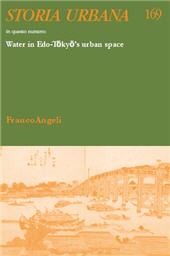Waterside Culture in Edo.
27-64 p.
The sea, natural rivers, minor rivulets, canals, ditches, moats, ponds and waterside were the very important places for Edo culture. Edo and Tōkyō, by dint of these waters, had become an extremely protean city. The Yoshiwara pleasure district served as a kind of cultural salon. It was frequented by the literati and painters of ukiyoe, who featured the district and its prostitutes in their works, which were printed and sold in large quantities by the printing houses, so that the pleasure districts prospered in a kind of interdependency with the publishing world. Yoshiwara had been built at the edge of the sea and even after moving inland it was a place many people would access by riverboats. Journeying along the river was to pass from the real world and enter into another. This different world that one access by a river journey from the real world also holds true for the theater districts. On the other hand, Asakusa was a location often used for important scenes.
With its long history, this area is deeply connected with the formation of Edo on the banks of the Sumida River. The Sumida River has been used with particular variety in the culture and stories of Edo. The Ryōgoku Bridge, especially, featured in many texts written in the Edo period. In this paper, I want readers to see the variety of images of Edo with water. [Publisher's text].
Il mare, i fiumi naturali, i rivoli minori, i canali, le dighe, i fossati, gli stagni e le sponde dell'acqua sono stati i luoghi più importanti per lo sviluppo della cultura di Edo che, grazie alla loro presenza, divenne una città estremamente proteiforme. Il quartiere dei piaceri di Yoshiwara era stato costruito in origine sul bordo del mare e, anche dopo essere stato trasferito nell'entroterra, fu un luogo a cui molte persone acÂÂ cedevano tramite battelli fluviali. Yoshiwara fungeva da salotto culturale, essendo frequentata da letterati e pittori di ukiyoe che la rappresentarono, insieme alle sue prostitute, nelle loro opere stampate e vendute in grandi quantità dalle tipografie, così che i distretti del piacere prosperarono in una sorta di interdipendenza con il mondo editoriale. Viaggiare lungo il fiume significava passare dal mondo reale a un mondo altro, così come accadeva anche quando si accedeva ai quartieri dei teatri.
Anche Asakusa, a sud di Yoshiwara, fu un luogo spesso utilizzato per scene imporÂÂ tanti, la cui storia era profondamente legata al fiume Sumida e alla stessa formazione di Edo attorno alle sue rive. Il Sumida fu infatti un protagonista di primo piano nella storia e nella cultura di Edo, così come il ponte Ryōgoku, il primo costruito per colÂÂ legare le due sponde del fiume. Questo articolo intende mostrare la varietà delle imÂÂ magini di Edo connesse con l'acqua, così come emerge dalle fonti letterarie e iconoÂÂ grafiche del tempo. [Testo dell'editore].
-
Articoli dello stesso fascicolo (disponibili singolarmente)
-
Informazioni
Codice DOI: 10.3280/SU2021-169002
ISSN: 1972-5523
PAROLE CHIAVE
- EdoTōkyō Yoshiwara Fiume Sumida Ponte Ryōgoku Asakusa Fiumi a Edo Cultura dell'acqua Quartiere dei teatri
- EdoTōkyō, Yoshiwara, Sumida River, Ryōgoku Bridge, Asakusa, rivers in Edo, waterside culture, theatre districts


